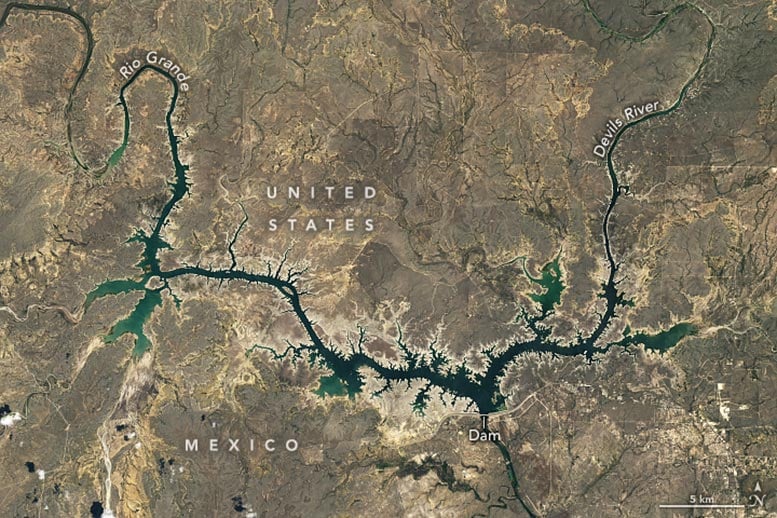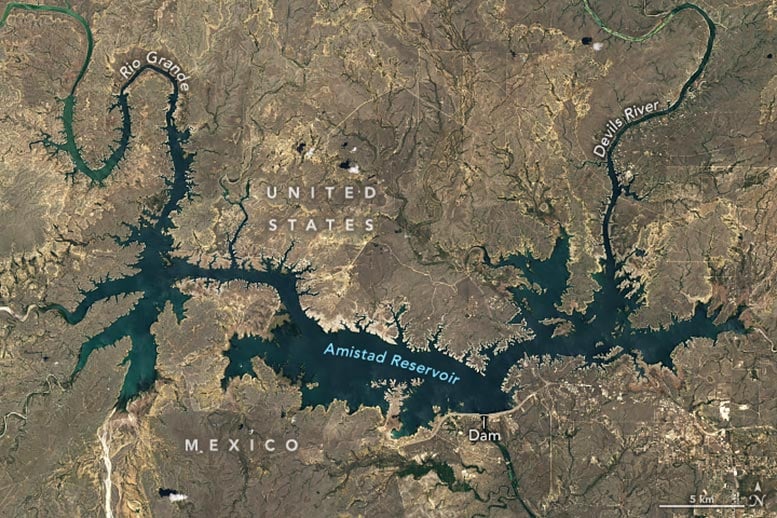The Crisis at Amistad Reservoir



In summer 2024, the Amistad Reservoir along the U.S.-Mexico border reached historically low water levels, holding less than a quarter of its capacity.
This alarming drop was part of broader severe drought conditions in southern Texas and northern Mexico, affecting local agriculture, energy production, and water supply. Heatwaves and prolonged droughts have exacerbated the situation, setting records for high temperatures and pushing the region’s water resources to their limits.
Record-Low Water Levels in Amistad Reservoir
A large reservoir in the Rio Grande Valley hit record-low levels in summer 2024, as the surrounding area in southern Texas and northern Mexico faced severe drought conditions. Amistad Reservoir, which straddles the U.S.–Mexico border, reached its lowest ever water level on July 17, 2024, when it held less than one-quarter of its capacity.
The image above (right) shows the lake on August 19, 2024, near its record-low level. For comparison, the other image (left) shows it in August 2016, during one of the higher periods in the past decade, which was still below its normal (or conservation) storage capacity. They were acquired by the OLI (Operational Land Imager) on Landsat 8 (lower) and the OLI-2 on Landsat 9 (upper).
The Dam’s Historical and Operational Context
This reservoir of the Rio Grande is formed by a dam approximately 6 miles (10 kilometers) long and up to 250 feet (75 meters) high. Completed in 1969, it was built jointly by the U.S. and Mexico to control floods, produce energy, and provide water for irrigation and municipal use.
Water levels in Amistad Reservoir have fluctuated widely in the past based on precipitation in the river basin and demands downstream. Previously, an extended drought left the reservoir low from 1992–2002, and subsequent droughts led to historic lows in 2013 and 2022. In July 2024, water levels dropped to more than 5 feet below the previous record, set in August 2022. The shriveling lake has restricted recreational access to its waters, and further drops would threaten the dam’s ability to produce hydropower.
Severe Drought Impacts in 2024
Watersheds that feed Amistad Reservoir have become parched. In the summer of 2024, “severe” and “extreme“ levels of drought, as classified by the North American Drought Monitor, afflicted much of the Rio Grande Basin upriver of the reservoir. These areas include West Texas and the Mexican states of Chihuahua and Coahuila. In addition, a heat dome parked extreme temperatures over Texas in late August 2024. The high in Del Rio (out of frame, to the southeast) hit 112 degrees Fahrenheit (44 degrees Celsius) on August 21, 2024, breaking the previous monthly high-temperature record of 110°F (43°C) set in 2023.
The dry conditions have persisted for over a year. Since summer 2023, one of the most severe droughts that Mexico has faced in more than a decade has parched crops, exacerbated fires, and strained water systems throughout the country. In Texas, “exceptional drought conditions” prompted a disaster proclamation in July 2022 that has remained in place through summer 2024. Some farmers in the Rio Grande Valley have been left without irrigation water, while some cities in Texas have set mandatory water restrictions for residents and businesses.
NASA Earth Observatory images by Michala Garrison, using Landsat data from the U.S. Geological Survey.
Source link



